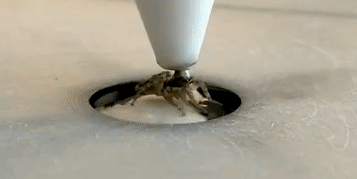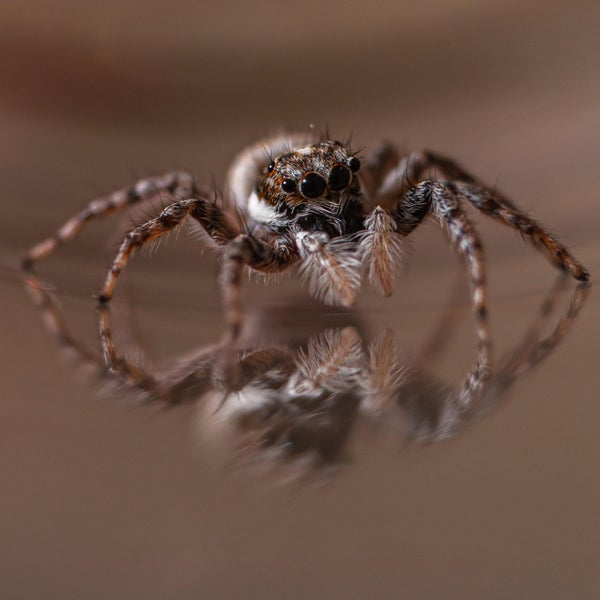Humans have long imagined what it would be like to see the world through different eyes. In Greek and Roman mythology, for example, the giant Argus Panoptes used his dozens of eyes to keep watch. The poet Ovid reported that they acted in independent pairs, with two at a time going to sleep while the rest remained alert.
A smaller many-eyed mystery fascinates scientists today: members of the family Salticidae, or jumping spiders, with their front pair of large, round eyes and three smaller peepers on each side of their head. A new study explores how these arachnids see—and, more specifically, what they care about seeing. Understanding how their eyes work together may inform future technologies, and offer a glimpse into a very different being’s perception.
“The results are indicative of cognitive processes that are sifting the world into categories of what is interesting—what is worth turning toward and investigating further, and what is not—what can be dismissed or ignored or kept in the corner of one's eye,” says Nathan Morehouse, a University of Cincinnati biologist, who studies jumping spider vision and was not involved in the study. “These are really questions about alien minds.”
On supporting science journalism
If you're enjoying this article, consider supporting our award-winning journalism by subscribing. By purchasing a subscription you are helping to ensure the future of impactful stories about the discoveries and ideas shaping our world today.
The “Cats of the Invertebrate World”
When Ximena Nelson teaches about these spiders at the University of Canterbury in New Zealand, she likes to do an experiment with her students. She warns them that she is about to project a vivid close-up of a jumping spider’s face on a large screen at the front of the room and then watches as even the self-described arachnophobes coo with delight, as if they were seeing a seal pup.
The spiders “are so relatable to us because they’ve got big eyes, and they look at you,” says Nelson, an animal behavior researcher. She reviewed the new study but was not involved in the work.

Researchers held a jumping spider’s head in place and allowed it to walk around on a spherical treadmill in order to track its motion. Credit: Federico Ferrante
Beyond their endearing aspect, however, it is these spiders’ unusual behavior that makes them rewarding research subjects—especially when studying perception. Unlike many arachnids, jumping spiders do not build webs or stay in one place. They scan their environment for prey, stalk it and then pounce to capture it. Ron Hoy, a Cornell University professor emeritus, who studies jumping spider neurology and was not involved with the research, says they act more like predatory felines. In fact, he says, the late influential neurologist Michael Land liked to call jumping spiders the “cats of the invertebrate world.”
The spiders’ near-360-degree eyesight helps them spot prey and hunt. But while their two large front eyes, called anterior medial eyes, have high acuity, those eyes’ field of vision is small. The lenses of the spiders’ eyes cannot swivel like those of humans, so when the arachnids want to shift their gaze, they simply reorient their entire body in the time it takes us to glance sideways. They pivot to face objects of interest (including potential prey, threats or mates) that they first spot with two of their less acute side-facing pairs of eyes, called the anterior and posterior lateral eyes.
This behavior led many scientists to think of these side eyes as mere motion detectors. But Massimo de Agró, now a researcher at the University of Regensburg in Germany, suspected they did more: the spiders seemed to use their lateral eyes to pick and choose what they turned toward. De Agró is the first author of the new study, which was published on Thursday in PLOS Biology and was based on experiments he conducted as a fellow at Harvard University.
Miniature Treadmills and a Light Show
Studying a jumping spider’s image processing is not as straightforward as implanting electrodes in its brain, as scientists might do with a larger animal. Not only is the spiders’ brain the size of a poppy seed, but these animals use hydrostatic pressure to extend their legs—this makes their whole body a bit like a “walking water balloon” that could pop from any invasive procedure, Morehouse says.
To track where jumping spiders were looking, de Agró and his co-authors used a popular technique for studying bumblebees and other small invertebrates. They floated a tiny, patterned ball on a cushion of upward-blowing air. Spiders were placed atop the ball and held in place from above. When they tried to turn their body by moving their legs, they would stay in place, but the ball would rotate, acting a little like a treadmill. A video camera recorded the ball’s movement and thus the spiders’ intended motion.
The researchers then simultaneously displayed two images in each spider’s periphery and noted which one it tried to turn toward in order to gauge which image it was more interested in investigating. One of the images tested was a series of moving dots that represented the “biological motion” of a spider walking from a side view—which the researchers were excited to find the arachnids could distinguish from randomly moving dots.
Hoy compares this abstraction to the “green screen” suits and white dots worn by actors when creating special effects for movies and TV shows: human brains will recognize a series of dots moving a certain way as human motion even before movie magic turns the dots into a superhero or zombie. “It’s very well known for humans, of course, that they can capture motion by abstract dots,” he says. “But the fact that they’re showing that this is also true for jumping spiders is pretty remarkable.”
De Agró, a psychologist by training, says this phenomenon was first described in humans in the 1970s—but that nobody had imagined invertebrates might be able to process the same abstraction. In addition to showing his spiders biological motion, he also created a dot display with a scrambled version of that same motion (which other animals have been shown to interpret as living movement, despite the scrambling) and another with random motion. All were shown to the arachnids’ anterior lateral eyes.
The spiders showed no preference between the biological and scrambled motion—yet they strongly preferred the random motion to either. De Agró says this result initially dismayed him because the random dots had been meant as a control that the spiders would not care to investigate.
“I was so sad when I saw the results of that first condition,” he says. “I was thinking, ‘What’s happening here? It’s clear there’s nothing happening.’” But then the spiders’ preferences stayed consistent across the other conditions.
De Agró concluded that the spiders may turn toward a moving image when they want more information about it—implying that the anterior lateral eyes not only detect motion but also give a jumping spider enough data to classify the motion into categories of living (spider dots and scrambled spider dots) and unknown (random dots).
Nelson says this study had an elegant design and surprising results. She also wonders whether male and female spiders might show different responses to these stimuli because females are much more focused on finding food, whereas males are singularly obsessed with finding a mate.
De Agró adds that he hopes the study will help arachnophobes see these spiders in a new light, especially given the invertebrates’ capability to engage in the kind of visual processing once presumed available only to humans and other mammals.
Learning how animals’ eyes function differently from ours may also widen the perspectives of programmers and robotics designers. Researchers have already created depth sensors—which can be used in video games, cars and phones—that were inspired by the way jumping spiders’ eyes work. Hoy says future iterations of these designs may benefit robots’ visual sensors on unfamiliar terrain, whether flying through a rain forest or exploring the surface of an extraterrestrial planet.
“Figuring out how that computation is made in an animal that has already outsourced a task to different eyes,” Hoy says, “would be a great way to think about how to design robots that have to navigate in an unpredictable, visually cluttered world.”
